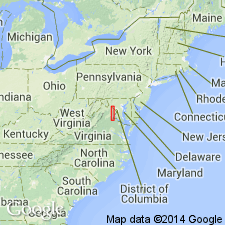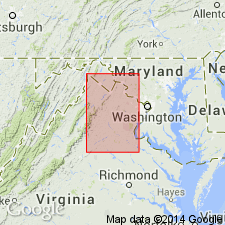
- Usage in publication:
-
- Cedar Mountain Conglomerate Member
- Modifications:
-
- Named
- Dominant lithology:
-
- Conglomerate
- AAPG geologic province:
-
- Piedmont-Blue Ridge province
- Culpeper basin
Summary:
The Cedar Mountain Conglomerate Member of the Bull Run Formation is here named. It consists of greenstone pebbles and boulders in a matrix which is red when fresh and gray when weathered or metamorphosed. It occupies a belt 31 km (20 mi) long and 3 km (5 mi) wide along the western margin of the Culpeper basin. Thickness ranges from 240 to 1,400 m (800 to 4,600 ft). Age is Late Triassic and Early Jurassic.
Source: GNU records (USGS DDS-6; Reston GNULEX).

- Usage in publication:
-
- Cedar Mountain Conglomerate Member†
- Modifications:
-
- Abandoned
- AAPG geologic province:
-
- Piedmont-Blue Ridge province
Summary:
The Cedar Mountain Conglomerate Member of the Bull Run Formation is here abandoned. It is replaced by the Mountain Run Member of the Tibbstown Formation.
Source: GNU records (USGS DDS-6; Reston GNULEX).
For more information, please contact Nancy Stamm, Geologic Names Committee Secretary.
Asterisk (*) indicates published by U.S. Geological Survey authors.
"No current usage" (†) implies that a name has been abandoned or has fallen into disuse. Former usage and, if known, replacement name given in parentheses ( ).
Slash (/) indicates name conflicts with nomenclatural guidelines (CSN, 1933; ACSN, 1961, 1970; NACSN, 1983, 2005, 2021). May be explained within brackets ([ ]).

